| dc.creator | Williams, Martyn | |
| dc.date.accessioned | 2020-08-06T21:54:43Z | |
| dc.date.available | 2020-08-06T21:54:43Z | |
| dc.date.issued | [2019] | |
| dc.identifier.uri | https://hdl.handle.net/1969.1/188593 | |
| dc.description | Case Study | en |
| dc.description.abstract | During a normal run cycle the compressor performance started to decline (again) due to chloride contamination, a known issue. The usual approach was to shut the process unit down and turn the compressor off, then removing the cartridge, cleaning out the chlorides and restarting the compressor and in turn the process unit, usually a 10 day exercise oil to oil of unplanned lost production and high maintenance costs that weren't budgeted for. On this occasion a higher suction temp was suggested, within 12 hours the compressor was back to optimal performance. | en |
| dc.format.medium | Electronic | en |
| dc.format.mimetype | application/pdf | |
| dc.language.iso | eng | |
| dc.publisher | Turbomachinery Laboratory | |
| dc.publisher | Texas A&M Engineering Experiment Station | |
| dc.relation.ispartof | Proceedings of the 48th Turbomachinery Symposium | en |
| dc.title | CST01 - Hydrogen Recycle Gas Compressor Fouling Mitigation Using Higher Suction Temperature | en |
| dc.type.genre | conference publication | en |
| dc.type.material | text | en |
| dc.format.digitalOrigin | born digital | en |
| dc.publisher.digital | Texas A & M University. Libraries | |


